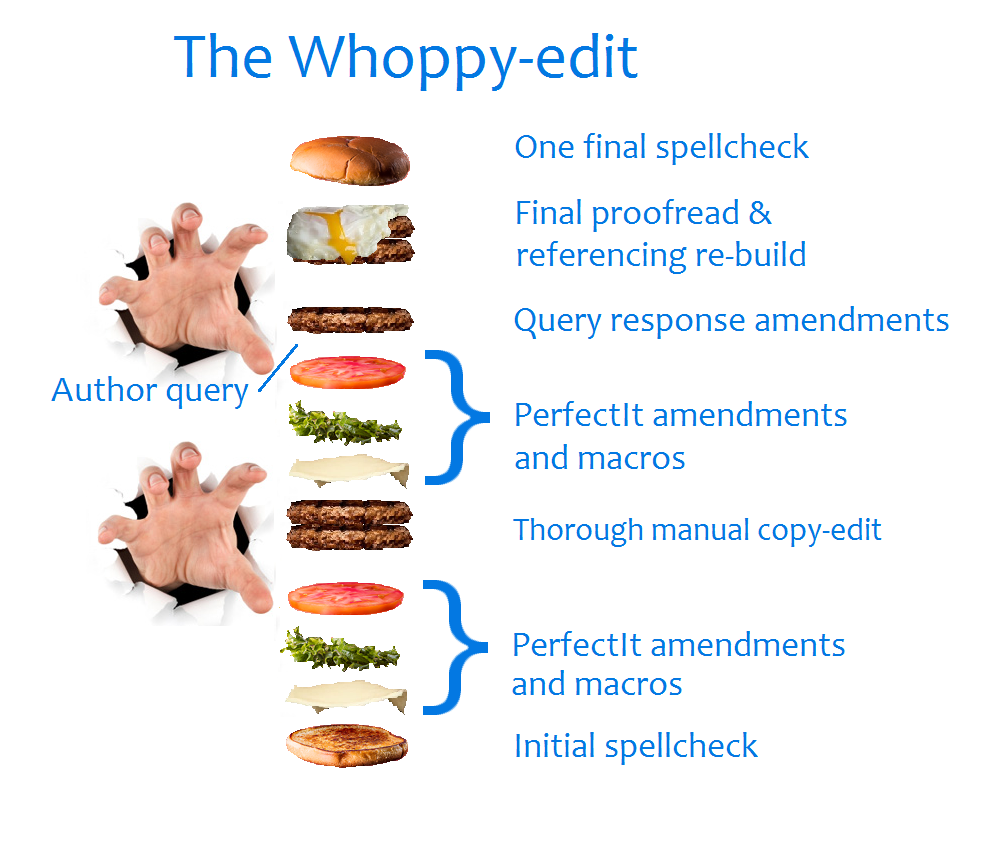The biggest proofreading service yet: the whoppy-edit!
This article is an example of the bespoke nature of the proofreading service and various editing services offered. Sometimes, a client cannot share a sample of the project ahead of quotation due to the nature of the project or end-client confidentiality clauses. In these cases, the service level can be hard to guess and often, a flexible approach has to be taken.
Continuing the build-a-burger analogy, but applying it to a proofreading service that matches my appetite for bread, cheese and meat, here's how a proofreading service can become...
The whoppy-editing service
This is an example of what can happen when someone's project requires some deep structural work and the scope becomes "do what it takes to get the document into shape".
First you order the copy-editing service burger...
The client asked for copy-editing of a very large (>150,000-word) multi-part multi-author technical report. It was in the field of engineering: right up my street; I was happy. Once the project got underway, it became clear that this project was in need of more than just a copy-edit.
It would have been possible to only copy-edit the file, and send it back with lots of queries and instructions for what needed doing but I can't help but feel a sense of responsibility for the service that I offer so if someone asks for a proofreading service but they need some aspects of a copy-editing service, then I will always discuss with the client the specifics of what I feel the document requires, and offer a bespoke service that meets their needs.
Then you realise how hungry you are!
In this particular case, the references needed researching and adding and because it was a multi-author technical report, the level of editing varied from substantive editing in places, to proofreading in other parts and, of course, there was the need to even out the writing styles – across multiple subdocuments – so the report read like a single coherent document.
This led me to name this bespoke proofread–copy-edit–referencing task "the whoppy-edit". Here is the anatomy of the whoppy-edit service:

For the client that ordered the whoppy-edit, the first manual stage was quite a heavy copy-edit. This stage raised a large number of queries to go back to the author(s): places where the original meaning was not clear, or inconsistencies that needed a choice to be made before they could be standardised.
In this case, the text had changed significantly as a result of the first copy-editing stage and so the second meaty layer was designed to make all of the amendments and edits required in response to the author(s) queries.
For any aspiring proofreaders or clients who wonder what a proofreading service, copy-editing service, or indeed a whoppy-editing service looks like, here it is broken down. This time, it was a combination of proofreading, copy-editing, editing, researching and referencing.
Rebuilding the references? Are you mad? That's not a proofreading or copy-editing service!
In this project, I noticed that in many cases, the reference list contained references that were not mentioned in the body of the technical report, and also, most worryingly, only half of the external documents referenced in the main body of the technical report actually had references. Fixing this was a big job. The client had a deadline looming and their consultants were needed on other projects so the inevitable question came: Can you fix it for us? The answer was yes, with some schedule flexing and long days, so I did.
After creating hyperlinked in-text references and a reference section for the technical report, it needed a proofread to make sure that the referencing, the author queries, and any final details and inconsistencies had been ironed out.
How did you manage the scope of works and quote for the proofreading service?
Well, this was one meaty burger. A day rate had been agreed with the client and a quote was made based on the number of days it would require to copy-edit the document. When the requirements became better-understood, then this initiated a process of communicating with the client about what was needed in order to get the document up to their required standard, and then agreeing a schedule of works for what service would be provided to what time and cost. With flexibility on my side on the schedule (I worked long days and two weekends) and on cost on the client's side, we got the project completed to a satisfactory schedule, on time.
Is there a lesson from any of this? I think not. One thing I am sure of though is that I could eat a big, juicy burger right now. I haven't got an analogy for chips, but I want those too.
